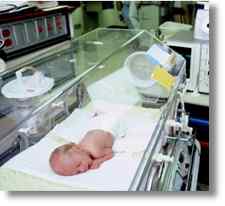
Premature infants, known as preemies, come into the world earlier than full-term infants. Prematurity occurs when a pregnancy lasts fewer than 37 weeks; full-term infants are born 38 to 42 weeks after the mother's last menstrual period (LMP).
There are many causes of preterm delivery. Sometimes it's caused by the mother's lifestyle choices during pregnancy: smoking, drinking alcohol, using drugs, eating poorly, not gaining enough weight, exposure to physical stress, and poor prenatal care are all causes of preterm delivery.
Often, however, the cause is not within the mother's control. The mother could have a hormone imbalance, a structural abnormality of the uterus, a chronic illness, an infection, or several other things that could lead to a premature birth. In addition, preterm delivery is more likely when a woman is over age 35, under age 19, or is carrying multiple fetuses. And sometimes the cause is simply unknown.
Premature infants have many special needs that make their care different from that of full-term infants, which is why they often begin their lives after delivery in a neonatal intensive care unit (NICU). The NICU is designed to provide an atmosphere that limits stress to the infant and meets basic needs of warmth, nutrition, and protection to assure proper growth and development.
Due to many recent advances, more than 90% of premature babies who weigh 800 grams or more (a little less than 2 pounds) survive. Those who weigh more than 500 grams (a little more than 1 pound) have a 40% to 50% chance of survival, although their chances of complications are greater.

A Preemie's Basic Needs
Warmth
Premature babies lack the body fat necessary to maintain their body temperature, even when swaddled with blankets. Therefore, incubators or radiant warmers are used to keep the babies warm. Incubators are made of transparent plastic, and they completely surround an infant to keep him or her warm, decrease the chance of infection, and limit water loss. Radiant warmers are electrically warmed beds open to the air. These are used when the medical staff needs frequent access to the baby for care.
Nutrition and Growth
Premature babies have special nutritional needs because they grow at a faster rate than full-term babies and their digestive systems are immature. Neonatologists (pediatricians who specialize in the care of newborns) measure their weight in grams, not pounds and ounces. Full-term babies usually weigh more than 2,500 grams (about 5 pounds, 8 ounces), whereas premature babies weigh anywhere from about 500 to 2,500 grams.
So, what are premature babies fed? Breast milk is an excellent source of nutrition, but premature infants are too immature to feed directly from the breast or bottle until they're 32 to 34 weeks gestational age. Most premature infants have to be fed slowly because of the risk of developing necrotizing enterocolitis (NEC), an intestinal infection unique to preemies. Breast milk can be pumped by the mother and fed to the premature baby through a tube that goes from the baby's nose or mouth into the stomach.
Breast milk has an advantage over formula because it contains proteins that help fight infection and promote growth. Special fortifiers may be added to breast milk (or to formula if breastfeeding isn't desired), because premature infants have higher vitamin and mineral needs than full-term infants. Nearly all premature babies receive additional calcium and phosphorus either by adding fortifier to breast milk or directly through special formulas for preemies. The baby's blood chemicals and minerals, such as blood glucose (sugar), salt, potassium, calcium, phosphate, and magnesium, are monitored regularly, and the baby's diet is adjusted to keep these substances within a normal range.
Common Health Problems of Preemies
Premature infants are prone to a number of problems, mostly because their internal organs aren't completely ready to function on their own. In general, the more premature the infant, the higher the risk of complications.
Hyperbilirubinemia
A common treatable condition of premature babies is hyperbilirubinemia, which affects 80% of premature infants. Infants with hyperbilirubinemia have high levels of bilirubin, a compound that results from the natural breakdown of blood. This high level of bilirubin causes them to develop jaundice, a yellow discoloration of the skin and whites of the eyes. Although mild jaundice is fairly common in full-term babies (about 60%), it's much more common in premature babies. Extremely high levels of bilirubin can cause brain damage, so premature infants are monitored for jaundice and treated quickly, before bilirubin reaches dangerous levels. Jaundiced infants are placed under special lights that help the body eliminate bilirubin. Rarely, blood exchange transfusions are used to treat severe jaundice.
Apnea
Apnea is another common health problem among premature babies. During an apnea spell, a baby stops breathing, the heart rate may decrease, and the skin may turn pale, purplish, or blue. Apnea is usually caused by immaturity in the area of the brain that controls the drive to breathe. Almost all babies born at 30 weeks or less will experience apnea. Apnea spells become less frequent with age.
In the NICU, all premature babies are monitored for apnea spells. Treating apnea can be as simple as gently stimulating the infant to restart breathing. However, when apnea occurs frequently, the infant may require medication (most commonly caffeine or theophylline) and/or a special nasal device that blows a steady stream of air into the airways to keep them open.
Anemia
Many premature infants lack the number of red blood cells necessary to carry adequate oxygen to the body. This complication, called anemia, is easily diagnosed using laboratory tests. These tests can determine the severity of the anemia and the number of new red blood cells being produced.
Premature infants may develop anemia for a number of reasons. In the first few weeks of life, infants don't make many new red blood cells. Also, an infant's red blood cells have a shorter life than an adult's. And the frequent blood samples that must be taken for laboratory testing make it difficult for red blood cells to replenish. Some premature infants, especially those who weigh less than 1,000 grams, require red blood cell transfusions.
Low Blood Pressure
Low blood pressure is a relatively common complication that may occur shortly after birth. It can be due to infection, blood loss, fluid loss, or medications given to the mother before delivery. Low blood pressure is treated by increasing fluid intake or prescribing medications. Infants who have low blood pressure due to blood loss may need a blood transfusion.
Respiratory Distress Syndrome
One of the most common and immediate problems facing premature infants is difficulty breathing. Although there are many causes of breathing difficulties in premature infants, the most common is called respiratory distress syndrome (RDS). In RDS, the infant's immature lungs don't produce enough of an important substance called surfactant. Surfactant allows the inner surface of the lungs to expand properly when the infant makes the change from the womb to breathing air after birth. Fortunately, RDS is treatable and many infants do quite well. When premature delivery can't be stopped, most pregnant women can be given medication just before delivery to hasten the production of surfactant in the infant's lungs and help prevent RDS. Then, immediately after birth and several times later, artificial surfactant can be given to the infant if needed. Although most premature babies who lack surfactant will require a breathing machine, or ventilator, for a while, the use of artificial surfactant has greatly decreased the amount of time that infants spend on the ventilator.
Bronchopulmonary Dysplasia
Bronchopulmonary dysplasia (BPD) is a common lung problem among premature infants, especially those less than 1,000 grams (2.2 pounds) at birth. The exact mechanism for this disease is still unclear, but extreme prematurity, severe RDS, infections before and after birth, and the prolonged use of oxygen and/or a ventilator needed to treat a lung disease all play a major role in the development of BPD. Preemies are often treated with medication and oxygen for this condition.
Infection
Infection is a big threat to premature infants because they're less able than full-term infants to fight germs that can cause serious illness. Infections can come from the mother before birth, during the process of birth, or after birth. Practically any body part can become infected. Reducing the risk of infection is why frequent hand washing is necessary in the NICU. Bacterial infections can be treated with antibiotics. Other medications are prescribed to treat viral and fungal infections.
Patent Ductus Arteriosus
The ductus arteriosus is a short blood vessel that connects the main blood vessel supplying the lungs to the aorta, the main blood vessel that leaves the heart. Its function in the unborn baby is to allow blood to bypass the lungs, because oxygen for the blood comes from the mother and not from breathing air. In full-term babies, the ductus arteriosus closes shortly after birth, but it frequently stays open in premature babies. When this happens, excess blood flows into the lungs and can cause breathing difficulties and sometimes heart failure. Patent ductus arteriosus (PDA) is often treated with a medication called indomethacin or ibuprofen, which is successful in closing the ductus arteriosus in more than 80% of infants requiring these medications. However, if medical therapy fails, then surgery may be required to close the ductus.
Retinopathy of Prematurity
The eyes of premature infants are especially vulnerable to injury after birth. A serious complication is called retinopathy of prematurity (ROP), which is abnormal growth of the blood vessels in an infant's eye. About 7% of babies weighing 1,250 grams (2.75 pounds) or less at birth develop ROP, and the resulting damage may range from mild (the need for glasses) to severe (blindness). The cause of ROP in premature infants is unknown. Although it was previously thought that too much oxygen was the primary problem, further research has shown that oxygen levels (either too low or too high) play only a contributing factor in the development of ROP. Premature babies receive eye exams in the NICU to check for ROP.

After the NICU
Premature infants often require special care after leaving the NICU, sometimes in a high-risk newborn clinic or early intervention program. In addition to the regular well-child visits and immunizations that all infants receive, premature infants receive periodic hearing and eye examinations.
Careful attention is paid to the development of the nervous system, including the achievement of motor skills like smiling, sitting, and walking, as well as the positioning and tone of the muscles.
Speech and behavioral development are also important areas during follow-up. Some premature infants may require speech therapy or physical therapy as they grow up. Infants who have experienced complications in the NICU may need additional care by medical specialists.
Also important is support of the family. Caring for a premature infant is even more demanding than caring for a full-term infant, and the high-risk clinics pay special attention to the needs of the family as a whole.
Reviewed by: Samir Alabsi, MD
Date reviewed: October 2007
Originally reviewed by: Joel D. Stenzel, MD




